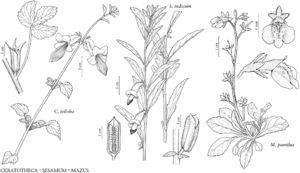Difference between revisions of "Sesamum indicum"
Sp. Pl. 2: 634. 1753. name conserved
FNA>Volume Importer |
imported>Volume Importer |
||
| (3 intermediate revisions by 2 users not shown) | |||
| Line 6: | Line 6: | ||
|place=2: 634. 1753 | |place=2: 634. 1753 | ||
|year=1753 | |year=1753 | ||
| + | |other_info_on_pub=name conserved | ||
}} | }} | ||
|common_names=Sesame;benne | |common_names=Sesame;benne | ||
| Line 13: | Line 14: | ||
}}{{Treatment/ID/Special_status | }}{{Treatment/ID/Special_status | ||
|code=F | |code=F | ||
| − | |label= | + | |label=Illustrated |
}} | }} | ||
|basionyms= | |basionyms= | ||
| Line 31: | Line 32: | ||
|elevation=0–1000 m. | |elevation=0–1000 m. | ||
|distribution=Ala.;Calif.;Fla.;Ga.;La.;Mass.;Mo.;N.J.;N.Y.;Ohio;Pa.;S.C.;Tex.;Wis.;origin unknown;probably s Asia (India);introduced also in South America;Europe;elsewhere in Asia;n Africa;Pacific Islands;Australia. | |distribution=Ala.;Calif.;Fla.;Ga.;La.;Mass.;Mo.;N.J.;N.Y.;Ohio;Pa.;S.C.;Tex.;Wis.;origin unknown;probably s Asia (India);introduced also in South America;Europe;elsewhere in Asia;n Africa;Pacific Islands;Australia. | ||
| + | |introduced=true | ||
|discussion=<p><i>Sesamum indicum</i> is the source of sesame seeds and sesame oil. It has been in cultivation for perhaps more than 5000 years; it is difficult to determine its native range. Sesame seeds are a component of many bird seed mixes, so plants often occur near feeders. The name <i>S. orientale</i> Linnaeus, which pertains here, has been rejected.</p> | |discussion=<p><i>Sesamum indicum</i> is the source of sesame seeds and sesame oil. It has been in cultivation for perhaps more than 5000 years; it is difficult to determine its native range. Sesame seeds are a component of many bird seed mixes, so plants often occur near feeders. The name <i>S. orientale</i> Linnaeus, which pertains here, has been rejected.</p> | ||
|tables= | |tables= | ||
| Line 40: | Line 42: | ||
-->{{#Taxon: | -->{{#Taxon: | ||
name=Sesamum indicum | name=Sesamum indicum | ||
| − | |||
|authority=Linnaeus | |authority=Linnaeus | ||
|rank=species | |rank=species | ||
| Line 55: | Line 56: | ||
|publication title=Sp. Pl. | |publication title=Sp. Pl. | ||
|publication year=1753 | |publication year=1753 | ||
| − | |special status=Introduced; | + | |special status=Introduced;Illustrated |
| − | |source xml=https:// | + | |source xml=https://bitbucket.org/aafc-mbb/fna-data-curation/src/2e0870ddd59836b60bcf96646a41e87ea5a5943a/coarse_grained_fna_xml/V17/V17_784.xml |
|genus=Sesamum | |genus=Sesamum | ||
|species=Sesamum indicum | |species=Sesamum indicum | ||
Latest revision as of 19:36, 5 November 2020
Stems simple or branched proximally, 4-angled, grooved, 30–100(–150) cm. Leaves: petiole 5–12 cm; blade narrowly lanceolate to ovate, 5–20 × 1–5 cm, base cuneate, apex acute, glabrate adaxially. Pedicels 3–5 mm; bracteoles 0–2, linear. Flowers drooping; sepals 4–8 mm; corolla 2–4 cm, glandular-pubescent externally, tube slightly curved at base, mouth 10 mm diam. Capsules 15–30 × 5–7 mm. Seeds 2–3 mm, smooth. 2n = (18), 32, 52 (Asia).
Phenology: Flowering Jun–Aug.
Habitat: Disturbed sites.
Elevation: 0–1000 m.
Distribution
Introduced; Ala., Calif., Fla., Ga., La., Mass., Mo., N.J., N.Y., Ohio, Pa., S.C., Tex., Wis., origin unknown, probably s Asia (India), introduced also in South America, Europe, elsewhere in Asia, n Africa, Pacific Islands, Australia.
Discussion
Sesamum indicum is the source of sesame seeds and sesame oil. It has been in cultivation for perhaps more than 5000 years; it is difficult to determine its native range. Sesame seeds are a component of many bird seed mixes, so plants often occur near feeders. The name S. orientale Linnaeus, which pertains here, has been rejected.
Selected References
None.
